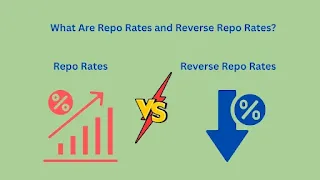Once Upon a Time in the World of Money: Unravelling Repo and Reverse Repo
Hey there, future money maestros! Have you ever wondered how the big banks and the government keep our economy running smoothly? It's a bit like a giant, super-important game of musical chairs, but instead of chairs, they're moving around something called "money."
And in this game, two very special moves are called the "Repo Rate" and the "Reverse Repo Rate." Don't worry, these aren't some secret handshake for adults. They're actually pretty simple ideas, and by the end of our chat today, you'll be able to explain them like a pro to your friends!
Imagine our economy as a big, bustling city. For everything to work, there needs to be just the right amount of money flowing around – not too much, and not too little. Think of it like water in a city's pipes. If there's too much water, there could be floods. If there's too little, everyone gets thirsty! The "Central Bank" – in many countries, this is like the super-smart mayor of the money city – is in charge of making sure the water (money) supply is just right.
Now, let's meet our two main characters: Repo and Reverse Repo.
Repo Rate: When Banks Need a Quick Loan
Let's say you're a big bank, like "MegaBank," and you suddenly need some extra money for a very short time. Maybe a lot of people want to withdraw their savings, or perhaps MegaBank has a great opportunity to lend money to a big company, but they're a little short on cash right now. It's like you're playing a board game and need a few extra dollars to buy a property, but your allowance hasn't come in yet.
What does MegaBank do? They can go to the Central Bank and say, "Hey, Central Bank, can we borrow some money for a day or two?" The Central Bank is usually happy to help, but just like when you borrow your friend's toy, you need to promise to give it back. And in the world of banks, they promise to give back the money by giving the Central Bank some really safe "stuff" as a guarantee. This safe stuff is usually government bonds, like special IOUs from the government.
Related Articles
What is a Central Bank? What is its significance?
So, MegaBank gives the Central Bank its government bonds, and in return, the Central Bank gives MegaBank the money it needs. But there's a catch! When MegaBank gives back the money, they have to pay a little extra for borrowing it. This extra amount is like interest. The "Repo Rate" is the interest rate at which the Central Bank lends money to other banks.
Think of it like this:
MegaBank needs money.
MegaBank gives government bonds (like valuable comic books) to the Central Bank.
Central Bank gives money to MegaBank.
Later, MegaBank gives the money back plus a little extra (the Repo Rate interest) to the Central Bank.
The Central Bank gives the government bonds back to MegaBank.
It's a "repurchase agreement" – Repo for short. MegaBank agrees to repurchase their bonds back later.
Why is the Repo Rate Important?
The Repo Rate is super important because it tells us how expensive it is for banks to borrow money from the Central Bank.
If the Repo Rate is high: It means borrowing money is expensive. Banks might not borrow as much, which means they might not lend as much money to people and businesses. This can slow down the economy if it's growing too fast (like a car going too fast, the Central Bank puts on the brakes).
If the Repo Rate is low: It means borrowing money is cheap. Banks might borrow more, which means they can lend more money to people and businesses. This can help the economy grow if it's a bit slow (like giving the car some gas).
Let's look at some numbers to make it real.
Table 1: Hypothetical Repo Rate Scenarios
Please note: These are hypothetical examples. Actual rates vary by country and economic conditions.
For example, in India, the Reserve Bank of India (RBI) sets the Repo Rate. If the RBI wants to control inflation (when prices go up too quickly), it might increase the Repo Rate. This makes it more expensive for banks to borrow, leading to less money flowing around, and hopefully, prices come down. In 2023, the RBI's Repo Rate saw some changes as it reacted to global economic conditions. For instance, in February 2023, the Repo Rate stood at 6.50% and remained steady through subsequent meetings for a significant period, helping to manage inflation.
Reverse Repo Rate: When the Central Bank Needs a Safe Place for Money
Now, let's flip the coin. What if the Central Bank has too much money floating around in the system? Remember our city's water pipes? If there's too much money, it can lead to inflation, where things become more expensive. The Central Bank wants to soak up some of that extra money.
This is where the "Reverse Repo Rate" comes in.
In this scenario, the Central Bank says to the other banks, "Hey, MegaBank, we have some extra money. Would you like to keep it for us for a short time? We'll give you some of our government bonds as a promise, and when we take our money back, we'll pay you a little extra for holding it."
So, the Central Bank gives money to MegaBank, and MegaBank gives the Central Bank some government bonds as a guarantee. When the Central Bank takes its money back, it pays MegaBank a small interest. This interest rate is the "Reverse Repo Rate."
Think of it like this:
The Central Bank has extra money.
The Central Bank gives money to MegaBank.
MegaBank gives government bonds (valuable comic books) to the Central Bank.
Later, the Central Bank takes its money back plus a little extra (the Reverse Repo Rate interest) from MegaBank.
MegaBank gives the government bonds back to the Central Bank.
It's a reverse repurchase agreement. The Central Bank is effectively selling its bonds with an agreement to repurchase them later.
Why is the Reverse Repo Rate Important?
The Reverse Repo Rate is crucial because it helps the Central Bank remove extra money from the banking system.
If the Reverse Repo Rate is high: It encourages banks to keep more money with the Central Bank because they get a better return. This helps absorb extra money from the system.
If the Reverse Repo Rate is low: Banks might not be as eager to keep their money with the Central Bank, meaning more money stays in circulation.
Table 2: Hypothetical Reverse Repo Rate Scenarios
Please note: These are hypothetical examples. Actual rates vary by country and economic conditions.
In India, the Reverse Repo Rate is usually lower than the Repo Rate. This encourages banks to lend money out to businesses and individuals rather than just parking it with the RBI. For instance, if the Repo Rate in India was 6.50%, the Reverse Repo Rate might be around 3.35% (this was indeed the rate for a significant period in 2023, for example). This difference is important because it creates a "corridor" for interest rates, guiding how much banks charge each other for loans.
Similarities: What Makes Them Like Brothers and Sisters?
Even though Repo and Reverse Repo seem like opposites, they share some important family traits:
Short-Term Money Movement: Both are used for moving money around for very short periods, usually overnight, but sometimes for a few days. Think of it as borrowing a cup of sugar from your neighbour – you plan to return it quickly.
Collateral (The Promise): In both cases, government bonds are used as "collateral." This is like a promise or a guarantee. If the money isn't returned, the other party gets to keep the bonds. It makes the transaction very safe.
Managed by the Central Bank: The Central Bank is the master conductor of both these operations. They use Repo and Reverse Repo to manage the amount of money in the economy.
Influence Interest Rates: Both rates directly influence other interest rates in the economy. If the Repo Rate goes up, it's likely that your bank loan rates will also go up eventually.
Control Inflation and Growth: Both are powerful tools the Central Bank uses to either slow down (fight inflation) or speed up (encourage growth) the economy.
Differences: What Makes Them Unique?
Now, let's look at how they are different, like two unique siblings with their own personalities:
Table 3: Repo Rate vs. Reverse Repo Rate
Connecting the Dots: Why Should We Care?
You might be thinking, "This is all about banks and the Central Bank. How does this affect me, a 7th grader?" Well, my friend, it affects everyone!
Imagine your parents are planning to buy a new car or a house. They'll likely need a loan from a bank. The interest rate on that loan is affected by the Repo Rate. If the Central Bank increases the Repo Rate to fight inflation, it becomes more expensive for your parents to borrow, meaning their monthly loan payments might be higher.
Or, if your grandparents have money in a savings account, the interest they earn on their savings is also indirectly influenced by these rates. When the Central Bank wants to encourage saving, it might make sure banks offer slightly better interest rates, which is often linked to the general interest rate environment influenced by Repo and Reverse Repo.
So, these seemingly simple transactions between banks and the Central Bank are actually the invisible strings that pull many of the economic puppets in our daily lives. They help keep prices stable, encourage businesses to grow, and ensure there's enough money flowing to keep our city (economy) healthy and buzzing.
The Story Continues...
The world of finance might seem complicated at first, but once you break it down into simple stories and relatable examples, it becomes much clearer. Repo and Reverse Repo are not just fancy terms; they are essential tools used by the Central Bank to steer our economy. By understanding them, you've taken a big step towards understanding how the world of money works.
Keep being curious, keep asking questions, and who knows, maybe one day you'll be one of the master conductors helping to manage the flow of money in our grand economic city!
Suggested articles for you:








